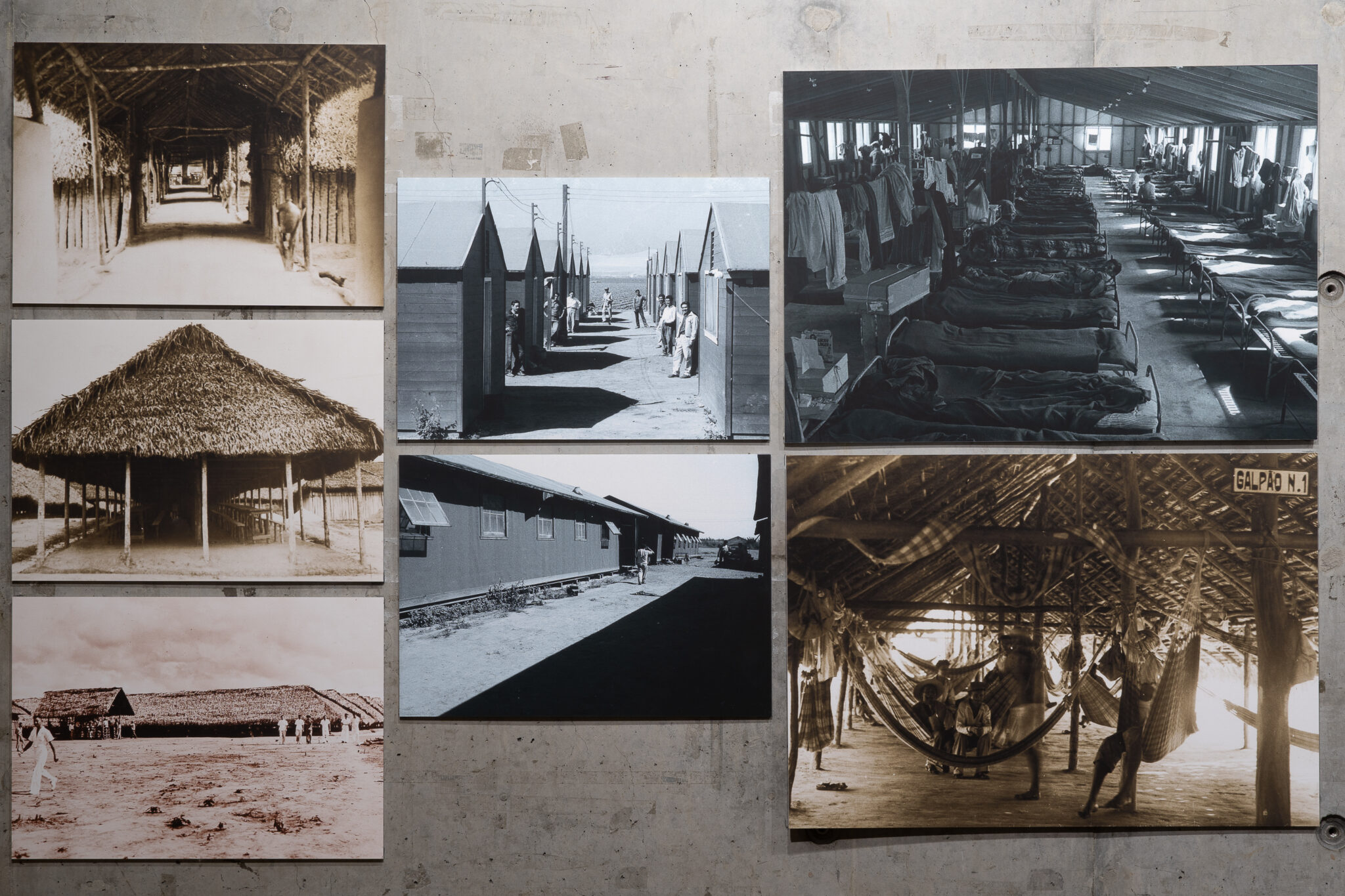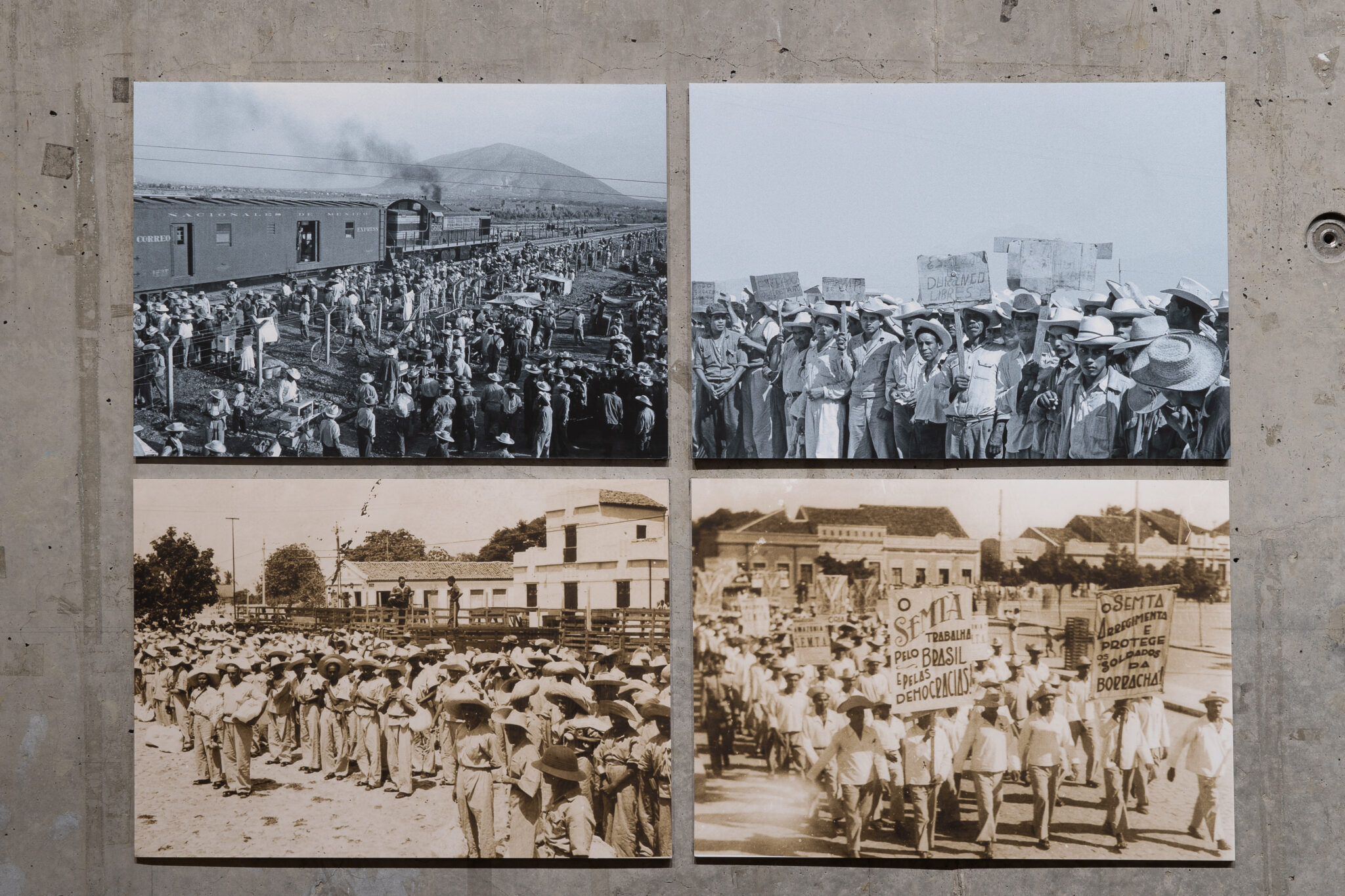From the Field
A Photo History of Labor and Power in the Americas
An exhibition at UC Berkeley’s Wurster Hall untangles themes of race, labor, and migration in the context of two US-sponsored agricultural worker programs during World War Two.

“Is that you who organized all of this?”
There I was, covered with sticky putty, kneeling on the ground holding the measuring tape and getting ready to hang the next photograph on the final wall for the “Braceros and Rubber Soldiers” exhibition. The showcase was on view in the elevator lobby of Bauer Wurster Hall at UC Berkeley and consisted of a series of historical posters and photographs juxtaposing two of the most important joint governmental programs between the US, Brazil, and Mexico during the Second World War. The Bracero Program brought 5 million temporary workers from Mexico to work on US farms between 1942 and 1964. The Rubber Soldiers program employed 60 thousand Brazilian rubber tappers to collect latex in the Amazon Forest for the Allies in 1943. Both programs were commissioned and financed by the US government, providing means of subsistence and essential goods for both the US army and the American population through the labor force of Latin American workers.
The Wurster Hall lobby was bustling with students coming and going from classes, studios, and the library, and that Tuesday was particularly busy during the semester. As I looked up from my work, I found the person who had asked about the show smiling.
“You know, my grandfather was a Bracero. He always tells me the stories of his time working on the lettuce fields here in California.”
Returning the smile, I felt both emotional and relieved. The exhibition had left an impression on someone as much as it had touched me. The pictures hanging on the walls had sparked conversations and piqued curiosity. In the days that followed, as I was photographing the exhibition or fixing things around, I encountered similar experiences with students and passersby. This exhibition was, in part, a celebration of the extensive research I had conducted for my doctoral work over the past seven years. While archival research can be solitary, being able to share some of my findings with a broader community — beyond my dissertation committee — underscored what academia and research mean to me: a reciprocal process of teaching and learning.

To complement doctoral research on Rubber Soldiers in Brazil, PhD candidate Laura Belik organized “The Braceros and the Rubber Soldiers: A History of labor and power in the Americas,” a photo exhibition highlighting historical photographs of the two temporary worker programs during World War Two. Photo by Dagin Faulkner
My doctoral research discusses topics such as camps, refugees and climate studies, spatial memory, heritage, and historical preservation. My work addresses two episodes within early twentieth-century Brazilian history: the 1932 concentration camps used as migrant labor camps for drought refugees in Northeast Brazil, and 1943 labor recruitment centers (pousos) housing Rubber Soldiers. This exhibition is a project I have undertaken alongside my doctoral work, focusing on the findings from my second case study, and opening new possibilities of dialogue when comparing it to the US-Mexico Bracero experience. My goal is to continue fostering this conversation more broadly, possibly making this a traveling show, exhibiting it in other institutions across Latin America, and perhaps continuing this comparative research as part of my postdoctoral work.
As opposed to writing a dissertation, putting together an exhibition and event series is a collaborative job, and I am thrilled to have found a community of people that were as excited to see this project take shape. This exhibition was made possible by the help of colleagues and professionals, as well as partnering institutions such as the Berkeley Food Institute. Other UC Berkeley sponsors include the Department of Architecture, Townsend Center for the Humanities, Chicanx Latinx Studies, Global Metropolitan Studies, Center for Race and Gender, Center for Latin American & Caribbean Studies, Department of Spanish & Portuguese, Department of Ethnic Studies and The Latinx Research Center. I am also grateful for the invited guest speakers who joined us in the opening events, Dr. Ignacio Ornelas Rodriguez (Stanford University/ Bracero Legacy Project), Brazilian filmmaker Wolney Oliveira (Federal University of Ceará/ Brazil) and Dr. Lorena Oropeza (UC Berkeley).

Filmmaker Wolney Oliveira (left) and Dr. Ignacio Ornelas Rodriguez (right) offered remarks at the exhibitions opening on February 15, 2024. Photo by Dagin Faulkner
“The Braceros and the Rubber Soldiers: A History of labor and power in the Americas” was on view at Bauer Wurster Hall from February 15 until March 15, 2024. This photo exhibition featured 15 pairs of historical images from the 1940s and 1950s, sourced from archives in Brazil (MAUC/UFC and Casa Oswaldo Cruz) and the United States (Smithsonian Archives Center). The show provided a visual narrative, juxtaposing photos depicting daily life within recruitment centers and lodging facilities for the Braceros and the Rubber Soldiers.
Through the lens of the built environment, this exhibition untangles complex themes such as race and racialization and their connections to labor and migration patterns, considering the power and influence of international politics and US imperialism. While the 1942 Emergency Farm Labor Program that brought Mexican guest workers to the US is well known within North American audiences, the Brazilian Rubber Soldiers’ experience remains less widely acknowledged. This exhibition helps us understand both the broad contextualization of these programs as part of a grand continental power dynamic and the closer examination of how these massive campaigns affected the people involved.



Photos in the exhibition are presented in pairs or thematic groups. It is fascinating to observe how, despite regional differences, both programs in Brazil and Mexico share similar formal and informal activities. Images capture moments of recruitment in workers’ hometowns, medical checkups, paperwork signing, transportation to farms or seringais (latex-producing areas in the Amazon), and daily life within assigned spaces.
While it is more common to see institutional images of the hands-on workers smiling while picking up tomatoes or delivering solid rubber pelotas (rubber balls), it is less frequent to see the everyday perspective of the workers themselves. Where did they sleep? How did they eat? How were the bathrooms like? What did they do for fun or on their free time? Some of these answers are buried within rarely accessed archives, yet these voices tell us as much — or even more — about us and our history than we might think we already know.
Click here to visit the Latin American Cities Working Group website for more information about the exhibition and to stay updated on where it will be featured next.